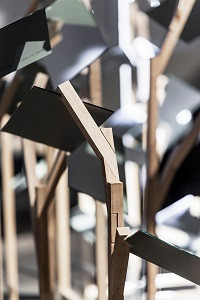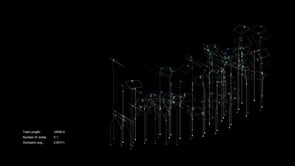
Reflective Growth
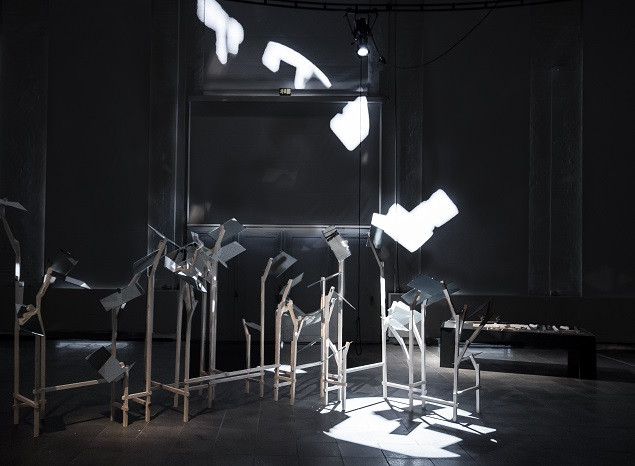
Reflective Growth from CITA on Vimeo.
Design can be understood as the negotiation of seemingly non-negotiable constraints. “How can computational approaches support the process of finding a balance between a complex set of requirements?”, is the question underlying the experiment Reflective Growth.
In the installation Reflective Growth two systems equipped with laws from physics and from traditional craft meet:
1) The reflection of light follows a clear rule: Incoming equals outgoing angle. This is the irrevocable outset for an array of mirrors that are programmed to reflect the light of a moving artificial sun to a set of targets.
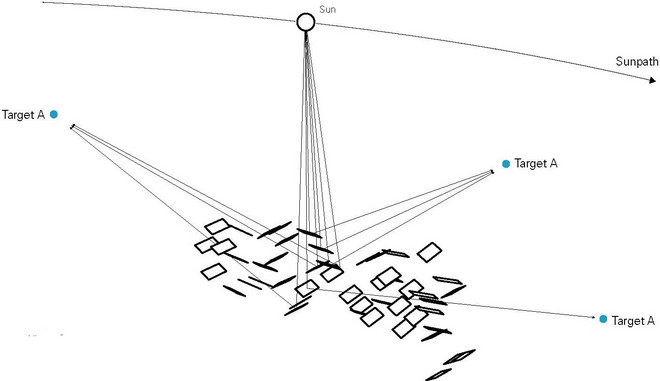
2) Construction systems with materials as wood find their limit in matter and fabrication. In the installation the knowledge about this is incorporated into a generative design system with feedback loops to simulation. This produces subsequently solely “buildable” solution and allows the design to make use of the benefits of wood joints in self-jigging and fast assembly. The course of the sun is a repeating spectacle and the modulation.
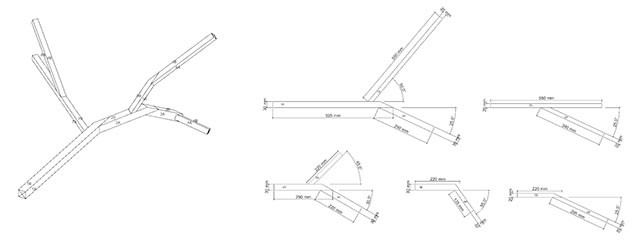
Background
Recent advances in computation allow to re-conceptualize the term optimization in the realm of design. The identification of the best solution within an often large set of potentials is typically associated with engineering. As architectural representation is shifting to parametric and generative logics the architectural design space is open to alternative means of assessment.
The limits of traditional optimization approaches, as fixity on set parameters and inflexibility to take on emerging one, can be overcome when the designer is able to interact with the multi-objective optimization environment and guide and amend the solution space. The absolute that accompanies the term optimal is shifting in the context of design to a temporal and project specific understanding – where fixed objectives transform to soft thresholds along the lines of Herbert Simons term of “satisficing”.

Description of material
Wood is the oldest building material and fits well into a future sustainable building practice. The practice of building with wood is characterized by a high degree of offsite pre-fabrication, where the clear logic of the structural system informs the making of traditional massive wood joints. These are self-registering and immediately stable when two pieces are connected. Notations on the wooden elements guide the builder.
Wood has however its limitations in strength, on the level of constructions through precision and achievable geometry as the process of fabrication are characterized by its own economies of time and budget.
Within the development of Reflective growth the different constraints were identified, and incorporated into the generative design system. Embracing goods craftsmanship rational approaches to the fabrication of many joints in a set of fixed angles were developed together with the Copenhagen Technical school (KTS). Samples underwent load tests at CITA and informed a structural simulation in the loop of the design system.
Experimental approach
The experiment is design based and takes the development of the exhibition piece as a case to inquire ways to implement optimization strategies into the design process. The parallel operating generative systems are different in nature: where the later follows a time based parametric logic that works on the whole array of mirrors simultaneously, the growth algorithms of the wood structure operate procedural, investigating the potentials for subsequent actions based on the potential at every step.
Tests and prototypes on digital as well as material level informed the integration of the two separate systems into a combined framework, where structural simulation, evaluation of light areas hit by the reflected beam as well as a judgment on aesthetic and construction level are constantly fed back into the proceeding design development and generative cycles.
